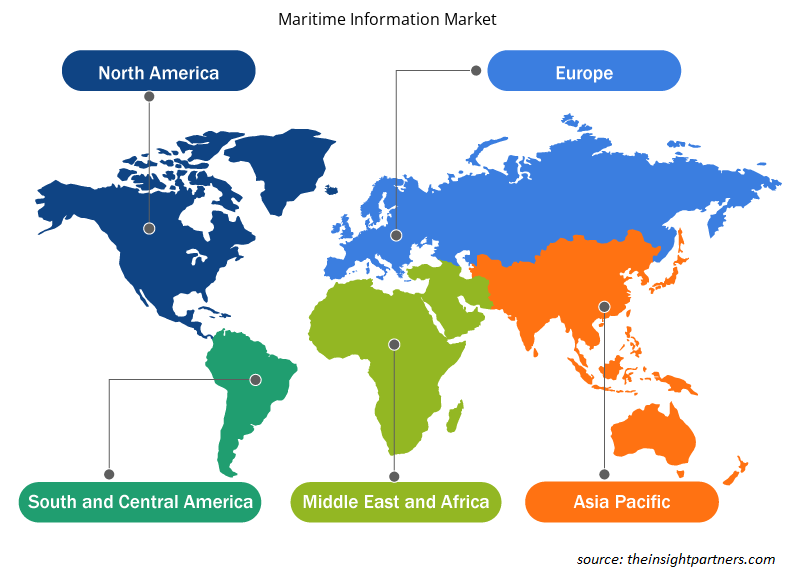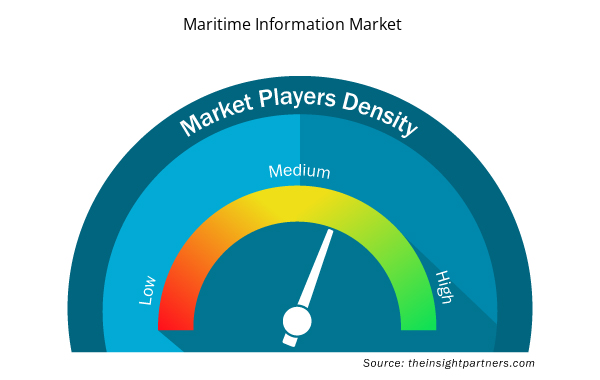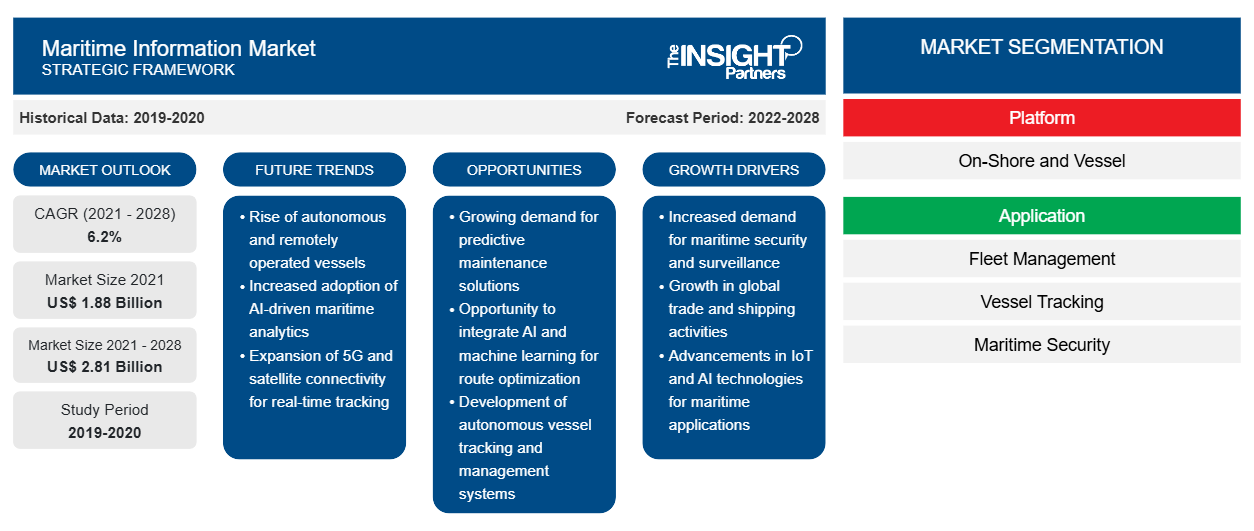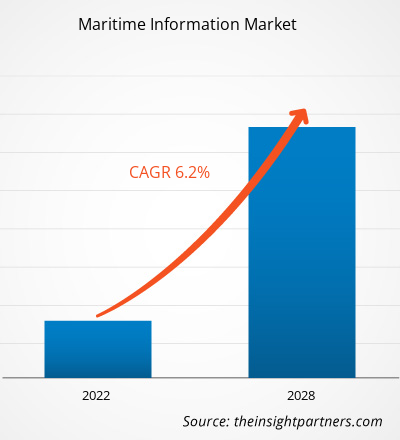海事情報市場は2021年に18億8,201万米ドルと評価され、2022年から2028年にかけて6.2%のCAGRで成長すると予想されています。CAGR of 6.2% from 2022 to 2028.
海事産業におけるデジタル変革により、ユーザーは海軍艦艇の所有権、移動、仕様、商業活動に関する重要な情報を収集できるようになりました。海事情報ソリューションは、複数のパラメータを監視することで船舶が荒れた海況に適応するのに役立ち、ユーザーはより適切な戦略的および運用上の決定を下すことができます。さらに、これらのソリューションは、生産性と全体的な安全性の向上、海上業務の効率性確保などの利点を提供します。このような要因により、海事情報市場の規模が拡大しています。
海事情報ソリューションは経済の安全を確保する上で重要な役割を果たしているため、世界中の政府機関で広く使用されています。これらのソリューションは、さまざまな国が人身売買、テロ攻撃、環境破壊、海からの不法移民などの海上の脅威を軽減するのに役立ちます。さらに、世界貿易の自由化により、海を渡る船舶の数が大幅に増加しており、これらのソリューションの需要が高まっています。さらに、国際海事機関(IMO)は、船舶の交通を監視し、他の船舶との衝突を回避するために、すべての船舶に自動識別システム(AIS)の搭載を義務付けています。さらに、海事業界のメーカーは、海軍艦艇からの信号を正確に検出する機能を実現するための研究開発活動に資金を提供しています。このような要因が海事情報市場の規模を押し上げています。
海上交通の増加に伴い、船舶の安全性とセキュリティを向上させ、環境を保護することが不可欠になっています。たとえば、インドの港湾局によると、2020年のインドの主要港の貨物輸送量は4億1,420万トンで、2020年第1四半期と比較して2021年には12.9%増加しました。さらに、情報交換により、海事産業のサプライチェーンのさまざまな部分が連携して円滑な運営を行うよう促されています。船舶交通監視機能と、AISや合成開口レーダー(SAR)などの効果的な追跡システムを備えた統合システムは、船舶にとって不可欠なものとなっており、海事情報市場の成長に貢献しています。
要件に合わせてレポートをカスタマイズする
このレポートの一部、国レベルの分析、Excelデータパックなど、あらゆるレポートを無料でカスタマイズできます。また、スタートアップや大学向けのお得なオファーや割引もご利用いただけます。
- このレポートの主要な市場動向を入手してください。この無料サンプルには、市場動向から見積もりや予測に至るまでのデータ分析が含まれます。
海事情報市場で事業を展開している大手企業には、インマルサット、L3ハリステクノロジーズ、ORBCOMM、レイセオンカンパニー、タレスグループ、exactEarth、イリジウムコミュニケーションズなどがあります。たとえば、2022年4月、Spire Globalは海事業界向けの気象情報ソリューションを発表しました。同社は、観測が困難だった外洋を含む遠隔地に到達する100機以上の衛星の完全配備されたコンステレーションを通じて、世界中の気象データを収集しています。Spiersは、機械学習と人工知能を通じて気象データと海洋の専門知識を組み合わせることで、気象に関する洞察を提供し、顧客の時間とコストを節約します。
2022年9月、BAEシステムズは、2024年までに初のマルチセンサー衛星クラスターを低軌道に打ち上げ、宇宙から軍事顧客に高品質の海洋情報とインテリジェンスをリアルタイムで提供する計画を発表しました。
COVID-19パンデミックが海事情報市場の成長に与える影響
COVID-19パンデミックは、海上貿易と輸送に長期的な影響を及ぼしました。港、海運業務、サプライチェーンは、パンデミック関連の制限により悪影響を受けました。原材料不足、リードタイムの問題、無航海、港の閉鎖、港の営業時間の短縮、設備と労働力の不足、輸送能力の制限は、危機中に船舶運航者が直面した困難の一部です。これらの障害は輸送サービスに深刻な損害を与え、サプライチェーンと貿易フローの円滑な運営を危険にさらします。いくつかの国と地域の海事業界は、COVID-19危機に関連するいくつかの港湾海事回覧を発行しました。
各国政府は、SARS-CoV-2の拡散を抑制するために渡航制限を課し、国境を閉鎖しました。その結果、港や空港が閉鎖されました。世界の貿易の約90%は海上輸送されています。さらに、各国政府が課した社会的および物理的な距離を置く措置により、港湾当局は船舶の運航を制限し、海事情報および分析ソリューションの需要が減少しました。しかし、2021年にロックダウンが解除され、ワクチン接種が成功したことで、いくつかの企業が業務を再開し、渡航制限が緩和されたことで海事業界は勢いを取り戻しました。このように、2021年には世界中で海事情報ソリューションの需要が増加しました。
市場洞察 – 海事情報市場
複雑なサプライチェーン業務の効率的な管理の必要性
海運業界は、効率性の向上、よりスマートな船舶や艦隊の構築、そして世界貿易の拡大への準備のためにデジタル化を取り入れています。世界的な供給ネットワークは拡大し、消費者需要の増加とともに複雑化しています。海運業界は、競争の激しい世界市場で効率を最大化し、サプライ チェーンを合理化するために、継続的に新しい戦略に取り組んで実装する必要があります。AI、ブロックチェーン、IoT、自動化などの革新的なテクノロジーを海運業務に統合することで、在庫データの整理、船舶の追跡と管理、情報の追跡、電子請求書の生成が容易になります。これらのテクノロジーを使用することで、海運会社は出荷、受領、追跡、注文データの収集に費やす時間を削減できます。これらのテクノロジーは、新たな商業的見通しの開発とサプライ ネットワークの変革に役立ちます。エンド ユーザーは、設計およびシミュレーション ツール、倉庫管理、輸送およびヤード管理、海事情報を活用したエンドツーエンドの物流ネットワーク制御を活用して、サプライ チェーン活動をうまく管理できます。さらに、輸送業者はコストを節約し、業務の持続可能性を確保する必要があるため、より厳しい環境規制が海運業界に影響を与え続けています。したがって、複雑なサプライチェーン業務を効率的に管理するニーズが高まることで、海事情報の市場シェアが拡大します。
プラットフォームベースのインサイト
海事情報市場は、プラットフォーム、アプリケーション、エンドユーザーに基づいてセグメント化されています。プラットフォームに基づいて、海事情報市場は陸上と船舶に分割されています。船舶セグメントは2021年に大きな市場シェアを占めました。海事情報市場で事業を展開している企業は、広範囲にわたる複雑な海洋プロジェクトに対応できるオフショア船の艦隊向けに、さまざまな海洋ソリューションとサービスを提供しています。現代の艦隊には、海中建設や曳航作業などの幅広いサービスを提供するために、新しいテクノロジー、効率的な推進システム、実証済みの信頼性が組み込まれています。艦隊船舶の数が増えるにつれて、船舶の運用と管理のための高度な海事情報ソフトウェアとサービスの需要が高まり、市場の成長を促進しています。
海事情報市場地域別インサイト
予測期間を通じて海事情報市場に影響を与える地域的な傾向と要因は、Insight Partners のアナリストによって徹底的に説明されています。このセクションでは、北米、ヨーロッパ、アジア太平洋、中東、アフリカ、南米、中米にわたる海事情報市場のセグメントと地理についても説明します。

- 海事情報市場の地域別データを入手
海事情報市場レポートの範囲
| レポート属性 | 詳細 |
|---|---|
| 2021年の市場規模 | 18億8千万米ドル |
| 2028年までの市場規模 | 28億1000万米ドル |
| 世界のCAGR(2021年~2028年) | 6.2% |
| 履歴データ | 2019-2020 |
| 予測期間 | 2022-2028 |
| 対象セグメント | プラットフォーム別
|
| 対象地域と国 | 北米
|
| 市場リーダーと主要企業プロフィール |
|
市場プレーヤーの密度:ビジネスダイナミクスへの影響を理解する
海事情報市場は、消費者の嗜好の変化、技術の進歩、製品の利点に対する認識の高まりなどの要因により、エンドユーザーの需要が高まり、急速に成長しています。需要が高まるにつれて、企業は提供内容を拡大し、消費者のニーズを満たすために革新を起こし、新たなトレンドを活用し、市場の成長をさらに促進しています。
市場プレーヤー密度とは、特定の市場または業界内で活動している企業または会社の分布を指します。これは、特定の市場スペースに、その規模または総市場価値と比較して、どれだけの競合相手 (市場プレーヤー) が存在するかを示します。
海事情報市場で事業を展開している主要企業は次のとおりです。
- BAEシステムズ
- スパイア・グローバル
- イリジウムコミュニケーションズ株式会社
- L3ハリステクノロジーズ
- ロッキード・マーティン社
免責事項:上記の企業は、特定の順序でランク付けされていません。

- 海事情報市場のトップキープレーヤーの概要を入手
海事情報市場で活動する企業は、主に高度で効率的な製品の開発に重点を置いています。
- 2021 年 10 月、宇宙ベースのデータと分析の世界的なプロバイダーである Spire Global, Inc. は、船舶の位置、気象条件、およびリアルタイムの意思決定を最適化できる世界的な海運活動組織に関する海洋データを提供する Spire の海事ソリューションのアップデートである Maritime 2.0 の提供開始を発表しました。
- 2022年9月、イリジウム コミュニケーションズ社は、大手海洋建設・土木会社であるJan De Nul Groupがイリジウムのグローバル海上遭難・安全システムソリューションを選択したと発表しました。イリジウムGMDSSの採用により、Jan De Nulは従業員に可能な限り最も安全な運用環境を提供するという確約を堅持しています。
海事情報市場は、プラットフォーム、アプリケーション、エンドユーザーに基づいてセグメント化されています。プラットフォームに基づいて、市場は陸上と船舶に分かれています。アプリケーションに基づいて、市場はフリート管理、船舶追跡、海上セキュリティに分かれています。エンドユーザーに基づいて、市場は商業と政府に分かれています。
海事情報市場は、北米、ヨーロッパ、アジア太平洋 (APAC)、中東およびアフリカ (MEA)、南米 (SAM) の 5 つの主要地域に分かれています。2021 年には、ヨーロッパが大きな収益シェアで市場をリードし、北米とアジア太平洋がそれに続きました。海事情報市場分析は、今後数年間の市場成長に影響を与えると予想される今後のトレンド、新技術、マクロおよびミクロ要因を理解するのに役立ちます。
会社概要:
- BAEシステムズ
- スパイア・グローバル
- イリジウムコミュニケーションズ株式会社
- L3ハリステクノロジーズ
- ロッキード・マーティン社
- オーブコム株式会社
- サーブ AB
- タレスグループ
- ウィンドワード株式会社
- ノースロップ・グラマン社
- ポールスター
- ワンオーシャン
- 富士通株式会社
- シーメンスAG
- 過去2年間の分析、基準年、CAGRによる予測(7年間)
- PEST分析とSWOT分析
- 市場規模価値/数量 - 世界、地域、国
- 業界と競争環境
- Excel データセット


- Analog-to-Digital Converter Market
- Electronic Data Interchange Market
- Helicopters Market
- Electronic Health Record Market
- Cosmetic Bioactive Ingredients Market
- Rugged Servers Market
- Integrated Platform Management System Market
- GMP Cytokines Market
- Airline Ancillary Services Market
- Space Situational Awareness (SSA) Market

Report Coverage
Revenue forecast, Company Analysis, Industry landscape, Growth factors, and Trends

Segment Covered
This text is related
to segments covered.

Regional Scope
North America, Europe, Asia Pacific, Middle East & Africa, South & Central America

Country Scope
This text is related
to country scope.
よくある質問
The US held the largest market share in 2022, followed by Germany.
The incremental growth, expected to be recorded for the Maritime information market during the forecast period, is US$ 851.58 million.
North America is the fastest growing regional market, followed by Europe.
US and Germany are expected to register high growth rates during the forecast period.
The key players, holding majority shares, in Maritime Information market includes Thales; Lockheed Martin; Northrop Grumman; L3Harris; and Bae Systems.
Emergence of Big Data Analytics and IoT, Information collected from large operation systems, such as ships and ports, is verified using data analytics which includes information about container weight, type, and destination. Additionally, it can analyze the ship’s trim, stability, engine performance, and communication data, among others. Big data analytics on ships can provide insights into historical container patterns and maritime conditions.
Need for Efficient Management of Complex Supply Chain Operations driving the need for Maritime information market. The marine industry is embracing digitalization in a bid to improve efficiency, build smarter ships and fleets, and attain readiness toward global trade expansion. Global supply networks are expanding and growing more complex with a rise in consumer demand. Marine businesses need to continuously work out and implement new strategies to maximize efficiencies and streamline supply chains in the fiercely competitive global marketplace.
The global Maritime Information market was estimated to be US$ 1,882.01 million in 2021 and is expected to grow at a CAGR of 6.2%, during the forecast period 2022 - 2028.
Trends and growth analysis reports related to Technology, Media and Telecommunications : READ MORE..
The List of Companies - Maritime Information Market
- BAE Systems Plc
- Spire Global
- Iridium Communications Inc.
- L3Harris Technologies Inc
- Lockheed Martin Corp
- ORBCOMM Inc
- Saab AB
- Thales Group
- Windward Ltd
- Northrop Grumman Corp
- Polestar
- ONEOCEAN
- Fujitsu Limited
- Siemens AG
The Insight Partners performs research in 4 major stages: Data Collection & Secondary Research, Primary Research, Data Analysis and Data Triangulation & Final Review.
- Data Collection and Secondary Research:
As a market research and consulting firm operating from a decade, we have published and advised several client across the globe. First step for any study will start with an assessment of currently available data and insights from existing reports. Further, historical and current market information is collected from Investor Presentations, Annual Reports, SEC Filings, etc., and other information related to company’s performance and market positioning are gathered from Paid Databases (Factiva, Hoovers, and Reuters) and various other publications available in public domain.
Several associations trade associates, technical forums, institutes, societies and organization are accessed to gain technical as well as market related insights through their publications such as research papers, blogs and press releases related to the studies are referred to get cues about the market. Further, white papers, journals, magazines, and other news articles published in last 3 years are scrutinized and analyzed to understand the current market trends.
- Primary Research:
The primarily interview analysis comprise of data obtained from industry participants interview and answers to survey questions gathered by in-house primary team.
For primary research, interviews are conducted with industry experts/CEOs/Marketing Managers/VPs/Subject Matter Experts from both demand and supply side to get a 360-degree view of the market. The primary team conducts several interviews based on the complexity of the markets to understand the various market trends and dynamics which makes research more credible and precise.
A typical research interview fulfils the following functions:
- Provides first-hand information on the market size, market trends, growth trends, competitive landscape, and outlook
- Validates and strengthens in-house secondary research findings
- Develops the analysis team’s expertise and market understanding
Primary research involves email interactions and telephone interviews for each market, category, segment, and sub-segment across geographies. The participants who typically take part in such a process include, but are not limited to:
- Industry participants: VPs, business development managers, market intelligence managers and national sales managers
- Outside experts: Valuation experts, research analysts and key opinion leaders specializing in the electronics and semiconductor industry.
Below is the breakup of our primary respondents by company, designation, and region:

Once we receive the confirmation from primary research sources or primary respondents, we finalize the base year market estimation and forecast the data as per the macroeconomic and microeconomic factors assessed during data collection.
- Data Analysis:
Once data is validated through both secondary as well as primary respondents, we finalize the market estimations by hypothesis formulation and factor analysis at regional and country level.
- Macro-Economic Factor Analysis:
We analyse macroeconomic indicators such the gross domestic product (GDP), increase in the demand for goods and services across industries, technological advancement, regional economic growth, governmental policies, the influence of COVID-19, PEST analysis, and other aspects. This analysis aids in setting benchmarks for various nations/regions and approximating market splits. Additionally, the general trend of the aforementioned components aid in determining the market's development possibilities.
- Country Level Data:
Various factors that are especially aligned to the country are taken into account to determine the market size for a certain area and country, including the presence of vendors, such as headquarters and offices, the country's GDP, demand patterns, and industry growth. To comprehend the market dynamics for the nation, a number of growth variables, inhibitors, application areas, and current market trends are researched. The aforementioned elements aid in determining the country's overall market's growth potential.
- Company Profile:
The “Table of Contents” is formulated by listing and analyzing more than 25 - 30 companies operating in the market ecosystem across geographies. However, we profile only 10 companies as a standard practice in our syndicate reports. These 10 companies comprise leading, emerging, and regional players. Nonetheless, our analysis is not restricted to the 10 listed companies, we also analyze other companies present in the market to develop a holistic view and understand the prevailing trends. The “Company Profiles” section in the report covers key facts, business description, products & services, financial information, SWOT analysis, and key developments. The financial information presented is extracted from the annual reports and official documents of the publicly listed companies. Upon collecting the information for the sections of respective companies, we verify them via various primary sources and then compile the data in respective company profiles. The company level information helps us in deriving the base number as well as in forecasting the market size.
- Developing Base Number:
Aggregation of sales statistics (2020-2022) and macro-economic factor, and other secondary and primary research insights are utilized to arrive at base number and related market shares for 2022. The data gaps are identified in this step and relevant market data is analyzed, collected from paid primary interviews or databases. On finalizing the base year market size, forecasts are developed on the basis of macro-economic, industry and market growth factors and company level analysis.
- Data Triangulation and Final Review:
The market findings and base year market size calculations are validated from supply as well as demand side. Demand side validations are based on macro-economic factor analysis and benchmarks for respective regions and countries. In case of supply side validations, revenues of major companies are estimated (in case not available) based on industry benchmark, approximate number of employees, product portfolio, and primary interviews revenues are gathered. Further revenue from target product/service segment is assessed to avoid overshooting of market statistics. In case of heavy deviations between supply and demand side values, all thes steps are repeated to achieve synchronization.
We follow an iterative model, wherein we share our research findings with Subject Matter Experts (SME’s) and Key Opinion Leaders (KOLs) until consensus view of the market is not formulated – this model negates any drastic deviation in the opinions of experts. Only validated and universally acceptable research findings are quoted in our reports.
We have important check points that we use to validate our research findings – which we call – data triangulation, where we validate the information, we generate from secondary sources with primary interviews and then we re-validate with our internal data bases and Subject matter experts. This comprehensive model enables us to deliver high quality, reliable data in shortest possible time.


 このレポートの無料サンプルを入手する
このレポートの無料サンプルを入手する